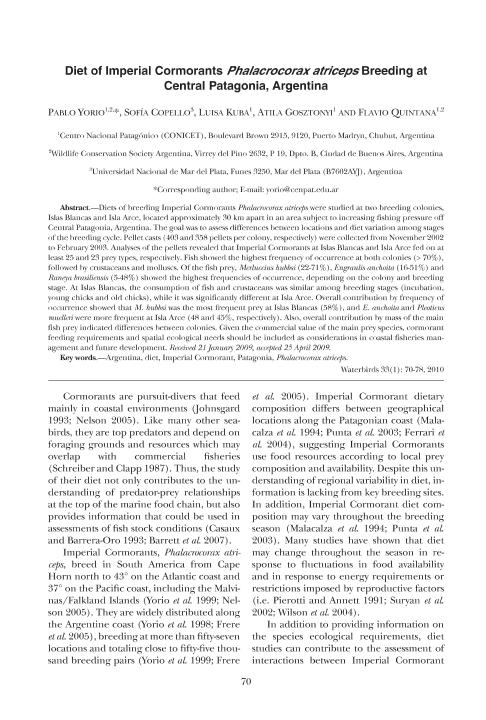Mostrar el registro sencillo del ítem
dc.contributor.author
Yorio, Pablo Martin

dc.contributor.author
Copello, Sofía

dc.contributor.author
Kuba, Luisa

dc.contributor.author
Gosztonyi, Atila Esteban

dc.contributor.author
Quintana, Flavio Roberto

dc.date.available
2018-10-29T14:22:03Z
dc.date.issued
2010-03
dc.identifier.citation
Yorio, Pablo Martin; Copello, Sofía; Kuba, Luisa; Gosztonyi, Atila Esteban; Quintana, Flavio Roberto; Diet of imperial Cormorants phalacrocorax atriceps breeding at Central Patagonia, Argentina; Waterbird Society; Waterbirds; 33; 1; 3-2010; 70-78
dc.identifier.issn
1524-4695
dc.identifier.uri
http://hdl.handle.net/11336/63174
dc.description.abstract
Diets of breeding Imperial Cormorants Phalacrocorax atriceps were studied at two breeding colonies, Islas Blancas and Isla Arce, located approximately 30 km apart in an area subject to increasing fishing pressure off Central Patagonia, Argentina. The goal was to assess differences between locations and diet variation among stages of the breeding cycle. Pellet casts (403 and 358 pellets per colony, respectively) were collected from November 2002 to February 2003. Analyses of the pellets revealed that Imperial Cormorants at Islas Blancas and Isla Arce fed on at least 25 and 23 prey types, respectively. Fish showed the highest frequency of occurrence at both colonies (> 70%), followed by crustaceans and molluscs. Of the fish prey, Merluccius hubbsi (2271%), Engranlis anchoita (1651%) and Raneya brasiliensis (548%) showed the highest frequencies of occurrence, depending on the colony and breeding stage. At Islas Blancas, the consumption of fish and crustaceans was similar among breeding stages (incubation, young chicks and old chicks), while it was significantly different at Isla Arce. Overall contribution by frequency of occurrence showed that M. hubbsi was the most frequent prey at Islas Blancas (58%), and E. anchoita and Pleoticus muelleri were more frequent at Isla Arce (48 and 45%, respectively). Also, overall contribution by mass of the main fish prey indicated differences between colonies. Given the commercial value of the main prey species, cormorant feeding requirements and spatial ecological needs should be included as considerations in coastal fisheries management and future development.
dc.format
application/pdf
dc.language.iso
eng
dc.publisher
Waterbird Society

dc.rights
info:eu-repo/semantics/openAccess
dc.rights.uri
https://creativecommons.org/licenses/by-nc-sa/2.5/ar/
dc.subject
Argentina
dc.subject
Diet
dc.subject
Imperial Cormorant
dc.subject
Patagonia
dc.subject
Phalacrocorax Atriceps
dc.subject.classification
Otras Ciencias Biológicas

dc.subject.classification
Ciencias Biológicas

dc.subject.classification
CIENCIAS NATURALES Y EXACTAS

dc.title
Diet of imperial Cormorants phalacrocorax atriceps breeding at Central Patagonia, Argentina
dc.type
info:eu-repo/semantics/article
dc.type
info:ar-repo/semantics/artículo
dc.type
info:eu-repo/semantics/publishedVersion
dc.date.updated
2018-10-12T18:12:23Z
dc.identifier.eissn
1938-5390
dc.journal.volume
33
dc.journal.number
1
dc.journal.pagination
70-78
dc.journal.pais
Estados Unidos

dc.journal.ciudad
Florida
dc.description.fil
Fil: Yorio, Pablo Martin. Consejo Nacional de Investigaciones Científicas y Técnicas. Centro Nacional Patagónico; Argentina. Wildlife Conservation Society; Estados Unidos
dc.description.fil
Fil: Copello, Sofía. Universidad Nacional de Mar del Plata; Argentina
dc.description.fil
Fil: Kuba, Luisa. Consejo Nacional de Investigaciones Científicas y Técnicas. Centro Nacional Patagónico; Argentina
dc.description.fil
Fil: Gosztonyi, Atila Esteban. Consejo Nacional de Investigaciones Científicas y Técnicas. Centro Nacional Patagónico; Argentina
dc.description.fil
Fil: Quintana, Flavio Roberto. Consejo Nacional de Investigaciones Científicas y Técnicas. Centro Nacional Patagónico; Argentina. Wildlife Conservation Society; Estados Unidos
dc.journal.title
Waterbirds

dc.relation.alternativeid
info:eu-repo/semantics/altIdentifier/doi/http://dx.doi.org/10.1675/063.033.0108
dc.relation.alternativeid
info:eu-repo/semantics/altIdentifier/url/http://www.bioone.org/doi/abs/10.1675/063.033.0108
Archivos asociados
